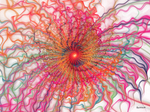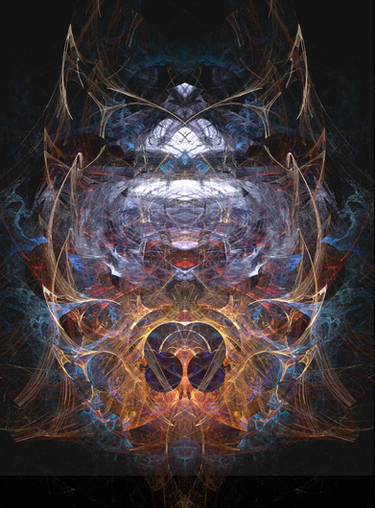Deviation Actions
The first class of terms describes the overall appearance of the fractal. I usually use the names of software to describe the overall appearance. This can be done because fractals have a tendency to be restricted in some ways to the program they are from. With the exception of JWildfire (which can be made to mimic Apophysis) and IncendiaEX (which can be made to mimic Mandelbulb), it's actually relatively easy (at least for me) to tell which program was used for a fractal. Don't believe me? Toss me a fractal with no program label and I'll take a guess. It's not some psychic power - if you've been looking at fractals a while, you're probably able to do this too. As of late, it is becoming a little bit more difficult to tell because people have started to figure out how to put strong, UF-style borders on their fractals in Apophysis.
The second class of terms is used to describe the fractal itself without respect to any program-specific features. I'll get into what that means, but first, the first class.
Fractal-type Adjectives
Notably, programs can create thousands of different shapes and some fractals can be described with these adjectives even if the program they originate from is not the origin of the adjective.Apophysian ("a-poh-fy-see-un)
- Refers to flame-like fractals (esp. fractals that resemble thin brush-strokes).Examples that most exemplify these traits:
 :thumb389976127:
:thumb389976127:Notice, of course, that Apophysis (2 and 7) are capable of quite a bit more, so those too are included in the definition, though the overlap between that and JWildfire fractals might lead to some confusion.
For example:

Notably, Apophysis curves tend to be more stringy than the curves produced by JWildfire. I consider this stringy nature as resembling more of a "true flame" (like a fire).
Mandelbrotian ("man-del-broh-shun")
- Refers to fractals whose shapes consist of Mandelbrots or possess a feature or features that resemble a Mandelbrot or are common in Mandelbrots (such as the ever-refining edge with increasing zoom).Behold, a Mandelbrot:

Obviously, the implementation can be alittle more creative:

... or even so complicated that the original Mandelbrot structure is difficult to see (if it even exists)
:thumb377804564:
The key to Mandelbrotian fractals that do not look like fractals is the ever-refining edge. If you've ever zoomed in on a Mandelbrot, you realize that its edge keeps changing the more you zoom in. All of a sudden, lines and curves start to appear where they did not exist. You could infinitely increase your zoom and find there would still be a unique pattern.
Visual example:
:thumb382891952:
Wildfire
- Refers to fractals whose characteristics resemble those that can be created with JWildfire.This is a very broad term because it covers a great number of fractals, including several flowers and various structures - some you can get from Apophysis and some you cannot (or at least, I've never seen them).
Behold, a common structure (notably, there is a touch of Mandelbrotian in this, but I would refer to it as "Wildfire" because of how common it is as a fractal from JWildfire):


One of the unique aspects about JWildfire fractals is their almost ghost-like or alien appearance. The fractal itself tends to lack the thickness you would see in UltraFractal creation but has too much to be the "brush stroke style" or flame-like appearance as in Apophysis. While you might contend this can be seen in Apophysis as well, Apophysis fractals tend to be more stringy.





And yet, the program is still capable of thick fractals:

Hence, there are a large range of fractals that fit under the description of "Wildfire". The best way to think of it is, "looks Apophysian but is not from Apophysis". There are, of course, many exceptions to this rule:

Incendianesque ("in-sen-dee-un-esk")
- Refers to fractals whose features resemble those created with the program IncendiaEX. Such fractals are always 3D with distinct lighting features. Fractals that also may fit in this category include those created with other 3D software.Since, by definition, a fractal must be mathematical construct or computer art (using math), other 3D software must do the same. When I invented this adjective, I considered all fractals that resemble 3D models, especially considering the wide range of capabilities of the program. Hence, if you created a model in Blender, even if it was by random math, the outcome would probably be Incendianesque. Be proud - it's a pretty word (at least in my book).

IncendiaEX is also capable of giving its fractals a cartoonish style that I have never seen applied to 3D models without some post-work. This, however, has some overlap with the term "Yueffiian", which I will describe later in this article.
Example:

Because of the program's capabilities, other fractals that fit under this description vary in style and appearance.
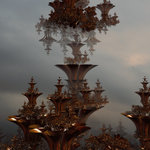

Mandelbulbous ("man-del-bal-bus")
- Refers to grandiose fractals, those with the appearance of being enormous in size. Many of their details are subtle, sometimes resulting in rigid, grainy textures.The mandelbulb itself looks huge, though it is not as grand as some of the fractal images you can make with it zoomed in or having its formula altered in some way.

Mandelbulb might be considered analogous to IncendiaEX on steroids. Despite the sheer number of pieces, there is a fluidity or means of unity between all of them such that the image generally creates an unmistakable whole.

 :thumb389852848:
:thumb389852848:The scenic backdrop for many Mandelbulb 3D fractals DOES NOT COUNT towards being "mandelbulbous".
Yueffian ("yoo-ef-ee-un")
- Refers to fractals whose boundaries and colors are very definitive, such as those created with UltraFractal. These fractals are often picturesque.This category tends to include both fractals from UltraFractal, which can have a cartoonish appearance because of the borders, and some from Apophysis.




It might be contended that some fractals from UltraFractal do not fit under this category, perhaps because their border are too soft or faded or because they are entirely different shapes. In such cases, they most likely fit under the terms "Apophysian" or "Wildfire".
Because UltraFractal and JWildfire are capable of importing images, some "fractals" are not pure fractals and thus are not described with this term (even though, as you may have guessed, it originates from UltraFractal and its acronym "UF").
Example of what is excluded:
raysheaf.deviantart.com/art/Th…
Sample
Given all that I've said, while it may be difficult to identify the original program in some cases, it is certainly possible to attach a label to it that might help you decipher the origin or at least help you categorize it.
For example:
:thumb364389085:
This image is a mixture of Wildfire and touch of Yueffian.
Sierpinkskian ("sehr-pin-skee-un")
- Refers to fractals of repetitious patterns of simple geometric shapes, as found in the Sierpinski triangle, Sierpinski hexagon, etc.Straightforward:

As is the nature of fractals, even repetitions of simple geometric shapes can create rather complex images.
:thumb389037740:
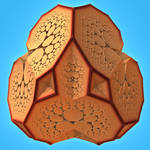

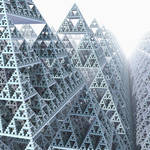
Unspecific Appearance Descriptors
The second class of descriptive words for fractals pays no attention to any specific shape within the fractal - only to its overall appearance.
IMPORTANT NOTE: Being "strong" in any one of these areas does NOT indicate that the fractal is more or less beautiful in any sense. Nor is it necessary for a "good" fractal to maintain some sort of balance between any two or more of the aspects described by these descriptors.
Focal Point Weight
- How much a fractal's features are concentrated around certain locations.
This can be good or bad, but either way, it tends to be very common in Apophysis fractals and never in any published Mandelbulb 3D fractals (never in any that I've seen at least).
The following example has very low focal point weight because, even though it is centered, the features are very clear and well distributed over the fractal:
The following is a perfect REAL example of strong focal point weight:
What strong or moderate focal point weight usually tends to look like:
Maximum strength for focal point weight results in single points of white on a black canvas (or black on white, depending on whichever happens to be the background color). Thus, obviously higher strength for focal point weight does NOT make a better fractal.
Strong focal point weight works nicely for Apophysis and "true flame" (fractals with the appearance of being fire) creators because real fire tends to be thickest near the source. However, this is not always the output of Apophysis, and very interesting, detailed flames can be created without having strong focal point weight.
Just to be clear one last time:
This fractal has strong focal point weight:
This fractal has weak focal point weight:
What is key here is that, though light is concentrated near the center, "activity" is not.
An easy way to remember "focal point weight" is to note its relationship to the fractal's "activity" (which I will explain next). If the "activity" is focused around certain points, then there is strong focal point weight.
Activity
- A subjective measurement of the number of lines, curves, shapes, and other features that are present in any square area of the fractal.
I use "square area" so as to indicate equal sampling of areas, disregarding the size of the sample square.
So for example, the following image has strong/high activity near the corners but relatively weak activity in the center:
While a great deal of activity can make a fractal more interesting at high zoom levels, it can make the overall image look grainy and thus hurt fractals whose primary feature is best viewed zoomed out.
(I will refrain from posting an example so as not to hurt anyone's feelings.)
Structure Play / Variation Play
- The visibility of different variations used in the fractal.
Whether intended or not by the designer, some fractals contain several different shapes and variations. Depending on the size of those shapes, this can result in several "layers" of the fractal, from what I call the "primary" lines and curves to the "subliminal" patterns and textures.
For example, this has very little structure play:
This has a medium-ish amount:
And this is extremely high:
Differentiating between Activity and Structure Play
Activity and structure play seem very similar with respect to the examples, and it seems in most cases, alot of structure play usually requires alot of activity, assuming you are hoping randomness will increase the probability of more shapes. This does not have to be the case, though I imagine it's more convenient.
To clarify the difference between a fractal's "activity" and its "structure play", I've created two sets of images that show increasing amounts of both. Notice that both can be quantitatively measured (in a manner of speaking) in a "square area".
Notice that when "activity" increases, the overall content in the square increased. The activity is depicted as random lines and curves because their shape is not important.
Notice that when "structure play" increases, there are more shapes visible. In the farthest right image, the same shapes have been used as in the middle image, but now these shapes form other structures (note that a kind of white structure has now become visible).
Final Exam
Now that you've studied all of these terms for describing fractals, try your luck at describing the following. Feel free to post your answers in a comment.
F) :thumb388968219:
Final Comments
Many thanks to those who made sure the "sharing buttons" were available for their fractals. That way, I can simply post the thumbnail here for people to see. I honestly don't know why people turn those off. (Do they want people to not see their work? It's not like it's going to prevent obnoxious people from taking it anyways.)
Many thanks to Andrea1981G for her fractals. I must say, I kept running into them when looking for examples, but I needed to give other people's stuff some time in the spotlight too.

